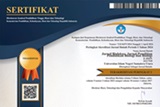The diversity of soil insects in rice field ecosystems
Abstract
Soil insects live in the soil or even both on the surface of the soil. Soil surface insects are one of the important animals in the soil ecosystem because their role is very important in the survival of the vegetation above them. Soil insects act as decomposers of organic materials, which will be useful as nutrients for plants. Apart from that, soil insects can also be used as indicators of soil fertility. The aim of this research is to determine the diversity of soil insects in the rice field ecosystem of Palembang City. This research was conducted in a rice field ecosystem using the pitfall trap method, 4 traps for 30 days. The results of the research obtained 14 species of soil insects from 11 families and the diversity index level of soil insects was classified as medium with a diversity index value of 1.057 with the dominating species, namely Camponotus laevigatus (Hymenoptera: Formicidae). Soil insects are an important part of an ecosystem or habitat. The diversity of ground surface insects and ecosystem functions show a very complex relationship and not much is known with certainty. A decrease in diversity and changes in the role of ground surface insects will occur due to changes in land use systems and habitats that are degraded due to development. The level of soil insect diversity needs to be maintained or increased to ensure soil fertility and overall ecosystem health and function remain optimal.
Keywords
Full Text:
PDFReferences
Abbas, M.J., & Parwez, H. (2020). Effect of habitat quality, microclimatic conditions and waste water contamination on diversity and distribution of collembola community. Asian Journal of Advances in research, 4(3), 35-43. https://doi.org/10.1101/668749
Adhikari, S., & Menalled, F.D. (2020). Supporting beneficial insects for agricultural sustainability: The role of livestock-integrated organic and cover cropping to enhance ground beetle (carabidae) communities. Agronomy, 10, 1210. https://doi.org/10.3390/agronomy10081210
Alekseev, S., & Ruchin, A. (2023). Spring distribution of beetles (Coleoptera: Carabidae) in abandoned agroecosystems and surrounding forests. E3S Web of Conference, 392, 02002. https://doi.org/10.1051/e3sconf/202339202002
Anjos, D.V., Caserio, B., Rezende, F.T., Ribeiro S.P., Del-Claro, K., & Fagundes, R. (2017). Extrafloral-nectaries and interspecific aggressiveness regulate day/night turnover of ant species foraging for nectar on Bionia coriacea. Austral Ecology, 42, 317–328. https://doi.org/10.1111/aec.12446
Anjos, D.V., Tena, A., Torezan-Silingardi, H.M., Pekas, A., & Janssen, A. (2021). Ants affect citrus pests and their natural enemies in contrasting ways. Biological Control, 158, 104611. https://doi.org/10.1016/j.biocontrol.2021.104611
Anjos, D.V., Tena, A., Viana-Junior, A.B., Carvalho, R.L., Torezan-Silingardi, H., Del-Claro, K., & Perfecto, I. (2022). The effects of ants on pest control: a meta-analysis. Proceedings of Royal Society B, 289, 20221316. https://doi.org/10.1098/rspb.2022.1316
Aristizábal, N., & Metzger, J.P. (2019). Landscape structure regulates pest control provided by ants in sun coffee farms. Journal of Applied Ecology, 56, 21–30. https://doi.org/10.1111/1365-2664.13283
Aronson, M.F.J., Handel, S.N., La Puma, I.P. & Clemants, S.E. (2015). Urbanization promotes non-native woody species and diverse plant assemblages in the New York metropolitan region. Urban Ecosystem, 18, 31–45. https://doi.org/10.1007/s11252-014-0382-z
Assunção, M.A., Torezan-Silingardi, H.M., & Del-Claro, K. (2014). Do ant visitors to extrafloral nectaries of plants repel pollinators and cause an indirect cost of mutualism?. Flora, 209, 244–249. https://doi.org/10.1016/j.flora.2014.03.003
Az, S.Z.N., Hariani, N., & Trimurti, S. (2018). Studi ketertarikan kecoak Jerman (Blattella germanica L.) pada karbohidrat dari ampas tahu dan ampas kelapa. Bioprospek, 13(1), 12-18.
Beillouin, D., Ben-Ari, T., Malézieux, E., Seufert, V., & Makowski, D. (2021). Positive but variable effects of crop diversification on biodiversity and ecosystem services. Global Change of Biology, 27, 4697–4710. https://doi.org/10.1111/gcb.15747
Bisseleua, D.H.B., Begoude, D., Tonnang, H., & Vidal, S. (2017). Ant-mediated ecosystem services and disservices on marketable yield in cocoa agroforestry systems. Agriculture, Ecosystem & Environment, 247, 409–417. https://doi.org/10.1016/j.agee.2017.07.004
Borror, D.J., Delong, D., & Triplehorn, C.A. (1996). An Introduction to the Study of Insects 5th. Saunder College Publ.
Brower, J.S., Zar, J.H., & Ende, N.O. (1990). Field and laboratory methods for general ecology, third edition. Brown.
Calabuig, A., Garcia-Marí, F., & Pekas, A. (2015). Ants in citrus: impact on the abundance, species richness, diversity and community structure of predators and parasitoids. Agriculture, Ecosystem & Environment, 213, 178–185. https://doi.org/10.1016/j.agee.2015.08.001
Caron, A.S., Koudji, E.G., Handa, I.T., Montoro-Girona, M., & Despland, E. (2023). Forest tent caterpillar outbreaks drive change in ant communities in boreal forests. Forests, 14, 1147.
https://doi.org/10.3390/f14061147
Cuthbert, R.N., Dick, J.T.A., Callaghan, A., & Dickey, J.W.E. (2018). Biological control agent selection under environmental change using functional responses, abundances and fecundities; the Relative Control Potential (RCP) metric. Biological Control, 121, 50-57.
Crowder, D.W., Jabbour, R. (2014). Relationships between biodiversity and biological control in agroecosystems: current status and future challenges. Biol. Control, 75, 8–17.
https://doi.org/10.1016/j.biocontrol.2013.10.010
Dao, H.T, Meats, A., Beattie, G.A.C., Spooner-Hart, R. (2014). Ant-coccid mutualism in citrus canopies and its effect on natural enemies of red scale, Aonidiella aurantii (Maskell) (Hemiptera: Diaspididae). Bull. Entomol. Res. 104, 137. https://doi.org/10.1017/S0007485313000187
Despland, E. & Lessard, J-P. (2022). Social predation by ants as a mortality source for an arboreal gregarious forest pest. Basic and Applied Ecology, 59, 82-91. https://doi.org/10.1016/j.baae.2022.01.001
Diamé, L., Rey, J.Y., Vayssières, J.F., Grechi, I., Chailleux, A., & Diarra, K. (2018). Ants: major functional elements in fruit agro-ecosystems and natural enemies. Sustainability, 10, 23.
https://doi.org/10.3390/su10010023
Ferguson, S.T., Bakis, I., Edwards, N.D., & Zwiebel, L.J. (2023). Olfactory sensitivity differentiates morphologically distinct worker castes in Camponotus floridanus. BMC Biology 21, 3.
https://doi.org/10.1186/s12915-022-01505-x
Huang, C.W., Mcdonald, R.I., & Seto, K.C. (2018). The importance of land governance for biodiversity conservation in an era of global urban expansion. Landscape Urban Plan, 173, 44-50.
https://doi.org/10.1016/j.landurbplan.2018.01.011
Husamah, Rahardjanto, A., & Hudha, A.M. (2017). Ekologi hewan tanah (teori dan praktik). UMM Press.
https://anyflip.com/bmnaq/aenw/basic/151-180
Janssen, A., & van Rijn, P.C.J. (2021). Pesticides do not significantly reduce arthropod pest densities in the presence of natural enemies. Ecology Letters, 24, 2010–2024. https://doi.org/10.1111/ele.13819
Jordan, H.R., & Tomberlin, J.K. (2017). Abiotic and biotic factors regulating inter-kingdom engagement between insects and microbe activity on vertebrate remains. Insects. 8, 54. https://doi.org/10.3390/insects8020054
Krebs, C.J. (1999). Ecological metodology, second edition. An Imprint of Addison Wesley Longman, Inc.
Kusumadinata, A.A., Sumardjo, Sadono, D., & Burhanuddin. (2020). Effect of farmers'
characteristics, information sources, and information quality on agriculture risk communication. International Journal of Science: Basic of Applied Research (IJSBAR), 54(2), 67-83.
Leal, L.C., & Peixoto, P.E. (2017). Decreasing water availability across the globe improves the effectiveness of protective ant–plant mutualisms: A meta-analysis. Biology Review, 92, 1785–1794. https://doi.org/10.1111/brv.12307
Magurran, A.E. (1996). Ecologycal diversity and its measurement. Chapman and Hall.
MacArthur-Waltz, D.J., Nelson, R.A., Lee, G., & Gordon, D.M. (2021). Tree preference and temporal activity patterns for a native ant community in an urbanized california woodland. J Insect Behav 34, 211–222. https://doi.org/10.1007/s10905-021-09778-w
Misganaw, M., Mengesha, G., & Awas, T. (2017). Perception of farmers on importance of insect pollinators in gozamin district of Amhara Region, Ethiopia. Biodiversity Internasional of Journal, 1(5), 54‒60. https://doi.org/10.15406/bij.2017.01.00029
Mohr, R.M. & Tomberlin, J.K. (2014). Environmental factors affecting early carcass attendance by four species of blow flies (Diptera: Calliphoridae) in Texas. Journal of Medical Entomology, 51, 702–708.
Mouratidis, A., Vacas, S., Herrero, J., Navarro-Llopis, V., Dicke, M., & Tena, A. (2021). Parasitic wasps avoid ant-protected hemipteran hosts via detection of ant cuticular hydrocarbons. Proceedings of Royal Society B, 288, 20201684. https://doi.org/10.1098/rspb.2020.1684
Offenberg, J. (2015). Ants as tools in sustainable agriculture. Journal of Applied Ecology, 52, 1197–1205. https://doi.org/10.1111/1365-2664.12496
Oktavianti, R., Nurdin, J., & Herwina, H. (2017). Komunitas Collembola pada hutan
konservasi dan perkebunan sawit di kawasan PT. Tidar Kerinci Agung (TKA), Sumatera Barat. Jurnal Biologi Universitas Andalas, 5(1),16–24
Parr, C.L., Dunn, R.R., Sanders, N.J., Weiser, M.D., Photakis, M., & Bishop, T.R. (2017). GlobalAnts: A new database on the geography of ant traits (Hymenoptera: Formicidae). Insect Conservations and Diversity, 10, 5–20.
https://doi.org/10.1111/icad.12211
Pérez-Rodríguez, J., Pekas, A., Tena, A., & Wäckers, F.L. (2021). Sugar provisioning for ants enhances biological control of mealybugs in citrus. Biology Control, 157, 104573. https://doi.org/10.1016/j.biocontrol.2021.104573
Perfecto, I., Vandermeer, J., & Philpott, S. M. (2014). Complex ecological interactions in the coffee agroecosystem. Annual Review Ecology, Evolotion and Systematics, 45, 137–158. https://doi.org/10.1146/annurev-ecolsys-120213-091923
Pol, J. C., Jimenez, S.I., & Gries, G. (2017). New food baits for trapping german cockroachs, Blattella germanica (L.) (Dictyoptera: Blattellidae). Journal of Economic Entomology, 6(110), 2518-2526.
Reta, H., Asfaw, Z., & Kelbessa, E. (2015). contribution of traditional farmers for medicinal plant conservation on the farming site in Gozamin Dis¬trict, Amhara Region, Ethiopia. International Journal of Life Sciences, 4(1), 24‒35.
Ruslan, A.S., Rushan, M.S., & Andrey, S.Z. (2020). Springtail (Hexapoda: Collembola) functional group composition varies between different biotopes in Russian rice growing systems. European Journal of Soil Biology. 99, 103208.
https://doi.org/10.1016/j.ejsobi.2020.103208.
Segre, H., Segoli, M., Carmel, Y., & Shwartz, A. (2020). Experimental evidence of multiple ecosystem services and disservices provided by ecological intensification in Mediterranean agro-ecosystems. Journal of Applied Ecology, 57, 2041–2053. https://doi.org/10.1111/1365-2664.13713
Spelleberg, I.F. (1995). Monitoring Ecological Change. Cambridge University Press.
Sujak, Rahardjo, B.T., Muhammad, F.N., & Rizali, A. (2023). Diversity and abundance of ants (Hymenoptera: Formicidae) as indicators of sugarcane agroecosystem stability in Blitar, East Java, Indonesia. Biodiversitas, 24 (10), 5336-5342.
https://doi.org/10.13057/biodiv/d241015
Sumah, A.S.W. (2023). Functional response of predator Paederus sp. (Coleoptera: Staphylinidae). Indonesian Journal of Applied Research (IJAR), 4(1), 53-62. https://doi.org/10.30997/ijar.v4i1.257
Sumah, A.S.W., & Kusumadinata, A.A. (2023). Kapasitas potensi parasitisme Trichogramma sp. (Hymenoptera: Trichogrammatidae) terhadap Corcyra sp. Jurnal Biosilampari: Jurnal Biologi, 5(2), 111-120.
https://doi.org/10.31540/biosilampari.v5i2.1894
Thurman, J.H., Northfield, T.D., & Snyder, W.E. (2019). Weaver ants provide ecosystem services to tropical tree crops. Frontier of Ecology and Evolution, 7, 120. https://doi.org/10.3389/fevo.2019.00120
Triplehorn, C.A., & Johnson N.F. (2005). Borror and delong’s introduction to the study of insect 7th edition. Thomson Brooks/Cole.
Qasim, M., Xiao, H., He, K., Noman, A., Liu, F., Chen, M-Y., Hussain, D., Jamal, Z.A., & Li, F. (2020). Impact of landfill garbage on insect ecology and human health. Acta Tropica, 211, 105630.
https://doi.org/10.1016/j.actatropica.2020.105630
Wäckers, F.L., Alberola, J.S., Garcia-Marí, F., & Pekas, A. (2017). Attract and distract: manipulation of a food mediated protective mutualism enhances natural pest control. Agriculture, Ecosystem, & Environment, 246, 168–174. https://doi.org/10.1016/j.agee.2017.05.037
Warino, J., Widyastuti, R., Rahayuningsih, Suhardjono, Y., & Nugroho, B. (2017). Keanekaragaman dan kelimpahan Collembola pada perkebunan kelapa sawit di Kecamatan Bajubang, Jambi. Jurnal Entomology Indonesia, 14(2), 51–57. https://doi.org/10.5994/jei.14.2.51
Widrializa, Widyastuti, R., Santosa, D.A., & Djajakirana, G. (2015). The diversity and abundance of springtail (Collembola) on forests and smallholder in Jambi. Journal of Tropical Soils, 20(3), 173–180. https://doi.org/10.5400/jts.2015.20.3
Wittwer, R.A., Bender, S.F., Hartman, K., Hydbom, S., Lima, R.A., & Loaiza, V. (2021). Organic and conservation agriculture promote ecosystem multifunctionality. Science of Advanced, 7, eabg6995. https://doi.org/10.1126/sciadv.abg6995
DOI: http://dx.doi.org/10.30821/biolokus.v6i2.3054
Refbacks
- There are currently no refbacks.
Copyright (c) 2024 Jurnal Biolokus: Jurnal Penelitian Pendidikan Biologi dan Biologi
indexed by :












